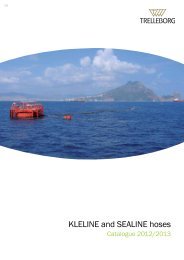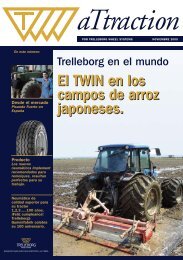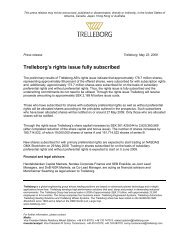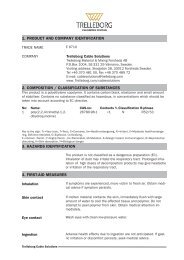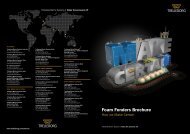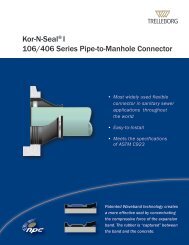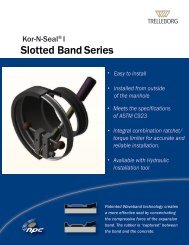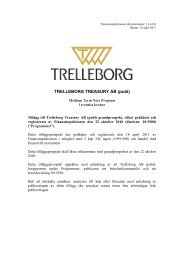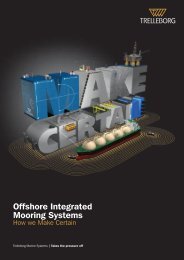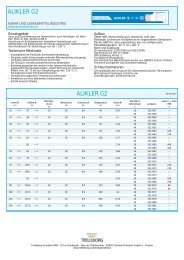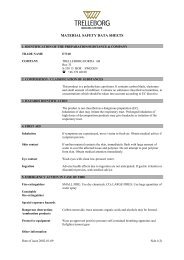Annual report 2011 - Trelleborg
Annual report 2011 - Trelleborg
Annual report 2011 - Trelleborg
You also want an ePaper? Increase the reach of your titles
YUMPU automatically turns print PDFs into web optimized ePapers that Google loves.
Dividend income<br />
Dividend income is recognized when the right to receive payment has been<br />
determined.<br />
Other operating revenue and expenses<br />
Other operating revenue and expenses include external rental revenue, capital<br />
gains from the sale and scrapping of property, plant, equipment and tools, and<br />
also gains or losses on sales of associated companies and subsidiaries.<br />
Borrowing costs<br />
The Group capitalizes borrowing costs that are directly attributable to acquisitions,<br />
construction or the production of a qualifying asset requiring a substantial<br />
period of time to complete for use or sale, as a portion of the cost of that<br />
asset. Other borrowing costs are expensed in the period in which they occur.<br />
Transaction costs for loans raised are recognized over the duration of the<br />
loan applying the effective interest method.<br />
Intangible assets<br />
Goodwill<br />
The amount by which the transferred consideration, any non-controlling interests<br />
and the fair value of previous shareholdings on the date of transfer exceeds the<br />
fair value of the Group’s share of identifiable acquired net assets is recognized<br />
as goodwill. Goodwill on acquisitions of subsidiaries is recognized as an intangible<br />
asset. Goodwill on acquisition of associated companies is included in the<br />
value of the investment in the associated company and is tested, taking into<br />
account possible impairment losses, as a portion of the value of the total<br />
investment. Goodwill that is recognized separately is tested annually to identify<br />
possible impairment losses and is measured at cost less accumulated impairment<br />
losses. Impairment losses on goodwill are not reversed. Gains or losses<br />
on the disposal of a unit include the remaining carrying amount of the goodwill<br />
attributable to the disposed unit. In the impairment tests, goodwill is allocated<br />
to cash-generating units. The allocation is made between the cash-generating<br />
units or groups of cash-generating units that are expected to benefit from the<br />
acquisition of operations giving rise to the goodwill item. These cash-generating<br />
units comprise the Group’s investments in each primary segment.<br />
Research and development<br />
Expenditure for development and research is expensed when it arises. Expenditure<br />
for development and testing of new or significantly improved materials,<br />
products, processes or systems is capitalized once the following criteria have<br />
been fulfilled:<br />
• it is technically feasible to complete the intangible asset such that it can be<br />
utilized or sold,<br />
• management intends to complete the intangible asset and utilize or sell it,<br />
• there are prerequisites in place to utilize or sell the intangible asset,<br />
• it can be demonstrated that the intangible asset will generate probable,<br />
future economic benefits,<br />
• adequate technical, economic and other resources are available to complete<br />
the development and to utilize or sell the intangible asset, and<br />
• the expenditure associated with the intangible asset during its development<br />
can be calculated in a reliable manner.<br />
Other development expenditure is expensed as incurred. Development expenditure<br />
previously expensed is not capitalized in subsequent periods. Capitalized<br />
development expenditure is recognized as intangible assets. Capitalized development<br />
expenditure has a finite useful life and is amortized straight-line from<br />
the point at which commercial production of the product commences. Amortization<br />
is based on the anticipated useful life, normally a period of five years.<br />
Other intangible assets<br />
Other intangible assets include externally acquired assets, such as capitalized<br />
IT expenditure, patents, brands and licenses. Assets with a finite useful life are<br />
measured at cost less accumulated amortization and impairment losses.<br />
Subsequent expenditure for an intangible asset is added at carrying amount or<br />
recognized as a separate asset, depending on which is suitable, only when it is<br />
probable that future economic benefits associated with the asset will accrue to<br />
the Group and the cost of the asset can be reliably measured. Other expenditure<br />
is expensed as incurred. Other intangible assets are amortized over their useful<br />
life, normally five to ten years.<br />
Property, Plant and Equipment (PPE)<br />
PPE primarily encompasses plants and offices. PPEs are measured at cost less<br />
accumulated depreciation and, where applicable, impairment losses. Cost<br />
includes expenses directly attributable to the acquisition of the asset. Cost may<br />
also include transfers from equity of gains and losses from cash-flow hedges<br />
relating to purchases in foreign currency, if these meet the requirements for<br />
hedge accounting.<br />
Depreciation is applied until the estimated residual value is reached. The<br />
residual value and useful life of the assets are assessed on each closing date,<br />
and, if necessary, are adjusted. The carrying amount of an asset is immediately<br />
impaired to the recoverable value if the carrying amount of an asset exceeds its<br />
NOTES – GROUP<br />
estimated recoverable value. See the section relating to impairment losses.<br />
Depreciation is based on cost and is allocated on a straight-line basis over the<br />
asset’s estimated useful life.<br />
The following depreciation rates apply:<br />
Land Not depreciated<br />
Buildings 1.5-6 percent<br />
Machinery 5-33 percent<br />
Tools and molds 33 percent<br />
Office equipment 10-20 percent<br />
Subsequent expenditure for a PPE is added to the carrying amount or recognized<br />
as a separate asset, depending on which is suitable, only when it is probable<br />
that the future economic benefits associated with the asset will flow to the<br />
Group and the cost of the asset can be measured in a reliable manner. The<br />
carrying amount of the replaced portion is derecognized from the balance sheet.<br />
All other forms of repairs and maintenance are expensed as incurred.<br />
Gains and losses on disposals are determined by comparing the sales<br />
proceeds and the carrying amount, and are recognized in profit and loss as<br />
other operating income and other operating costs, respectively.<br />
Leasing<br />
Lease contracts for PPE are classified as either finance leases or operating<br />
leases. Finance leases apply when the financial risks and rewards related to<br />
ownership are, for all practical purposes, transferred to the Group. At the inception<br />
of the lease period, financial leases are recognized on the basis of the<br />
leased asset’s fair value, or at the present value of the lease payments, whichever<br />
is lower. The leased asset is recognized as PPE. Each lease payment is<br />
divided into amortization of the liability and financial costs to achieve a fixed<br />
interest rate for the recognized liability. The equivalent payment undertaking,<br />
less financial costs, is included as an interest- bearing liability. The interest<br />
portion of the financial costs is recognized in profit and loss over the lease<br />
term, so that each <strong>report</strong>ing period is charged with an amount equivalent to a<br />
fixed interest rate for the liability recognized for each period. PPE held under<br />
finance lease agreements are depreciated in accordance with the same principles<br />
applicable to other assets of the same type, according to plan, or over the<br />
leasing period if it is shorter and the right of ownership is not expected to be<br />
transferred at the end of the leasing period. Lease agreements not classified as<br />
finance leases represent operating leases. Lease payments for operating leases<br />
are expensed as operating costs straight-line over the term of the lease.<br />
Impairment losses on non-financial assets<br />
Assets with an indefinite useful life, for example goodwill, are not amortized but<br />
are tested annually for impairment. Assets that are subject to amortization/<br />
depreciation are reviewed for impairment whenever events or changes in circumstances<br />
indicate that the carrying amount may not be recoverable. Impairment<br />
losses are recognized in the amount by which the carrying amount of the asset<br />
exceeds its recoverable amount, which is the highest of fair value less selling<br />
costs and value in use. Value in use refers to the total present value of the estimated<br />
future cash flows and the calculated residual value at the end of the<br />
useful life. In calculating value in use, future cash flows are discounted at an<br />
interest rate that takes into account the market’s assessment of risk-free<br />
interest and risk related to the specific asset, known as WACC (Weighted<br />
Average Cost of Capital). The Group bases the calculation on achieved earnings,<br />
forecasts, business plans, financial forecasts and market data. For assets<br />
dependent on other assets generating cash flow, the recoverable amount is<br />
calculated for the smallest cash-generating unit to which the asset belongs. The<br />
cash-generating units comprise the Group’s operating segments. Impairment<br />
losses are reversed if there is a change in the recoverable amount, with the<br />
exception of impairment losses on goodwill.<br />
Fixed assets held for sale<br />
Fixed assets (or disposal groups) are classified as held for sale when their<br />
carrying amounts will primarily be recovered on the basis of a sales transaction,<br />
and when a sale is deemed to be highly probable. These assets are recognized<br />
at the lower of carrying amount or fair value, less selling expenses, if their<br />
carrying amounts will primarily be recovered on the basis of a sales transaction,<br />
and not through continuous use.<br />
Financial instruments<br />
Financial instruments recognized in the balance sheet include the following<br />
assets and liabilities: cash and cash equivalents, securities, other financial<br />
receivables, accounts receivable, accounts payable, loans and derivatives.<br />
A financial asset or liability is initially recognized in the balance sheet when<br />
the company becomes a party to the contractual conditions of the instrument.<br />
A financial asset is derecognized from the balance sheet when all benefits<br />
and risks associated with ownership have been transferred. A financial liability<br />
is derecognized from the balance sheet when the obligations of the contract<br />
have been met, or otherwise extinguished.<br />
Financial instruments are initially measured at fair value and, subsequently,<br />
at fair value or accumulated amortized cost, depending on their classification.<br />
All financial derivatives are measured at fair value. The purchase and sale of<br />
<strong>Annual</strong> Report <strong>2011</strong> <strong>Trelleborg</strong> AB 77




